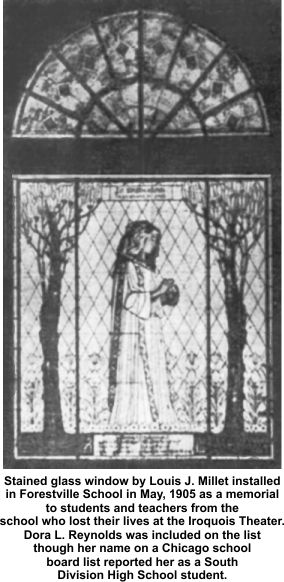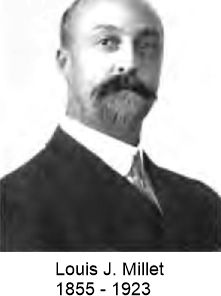|

Other Forestville† school students who lost their lives at the Iroquois Theater included
Willy Hennessy,
Leon Frady,
Erna and Ernest Reiss and teacher
Minnie Schaffner. The Forestville school was located in the Hyde Park area of Chicago on 45th and St. Lawrence Ave (eventually designated as 622 E. 45th St in 1903, later as 4439 St. Lawrence). The Millet window was placed above the landing on the stair in the southwest hall on the third floor. Forestville School was shuttered in 1976. It was remodeled several times over the years and newspapers did not report on what became of the Millet window. In April 1928 an addition to the school resulted in the school bell being removed from the tower. A group of African American students successfully petitioned to have the bell reinstalled in the remodeled structure. Clues to the fate of the window might be found at the Chicago Public Library.
|

Louis J. Millet, designer of the Forestville stained glass window, was educated in New York and Paris.
In addition to serving as an
instructor at the Chicago Art
Institute for over three decades,
Millet did interior design and
architectural decorative work on
many structures in Chicago.
The proscenium arch at the Auditorium
Theater and a frieze on the facade
of the Transportation Building and
stained glass projects at the 1893
Columbian Exposition in Chicago were
among his works. For a decade he
partnered with George P. Healy, a
fellow former student at the School
of Fine Arts in Paris. Healy &
Millet provided decorative
work for chuches and other
structures in Chicago, Colorado, St.
Paul, Seattle and Las Vegas. As an
outgrowth of their friendship with
Louis H. Sullivan while all three
were students in Paris, Healy &
Millet often worked on Adler &
Sullivan projects. Their work was
popular with the wealthy, including
Potter Palmer. They exhibited two of
their stained glass windows at the
1889 Paris Exposition and pioneered
a new approach to stained glass
design. The chief distinction was
that their designs incorporated
mosic and colored and textured
opalescent glass rather than painted
glass common to European designs. In
1904 he was hired as Chief of the
the Department of Mural and
Decorative Painting at the S. Louis
Worlds Fair.
|
|
|

|
Dora and Ruth waited on the third floor fire escape landing
while Dora's mother, Dora E. Thomas Reynolds (b.
1868–aft1936), crossed a plank stretched across Couch Place
alley from the gallery balcony fire escape to
Northwestern University. Mrs. Reynolds,
reportedly the first person to try the crossing, made it to safety, but both girls
died, either from flames or falling to the alley
below. It is not known whether Ruth's mother, Annie Stratman, was at the theater and survived or was not
present.
The Reynolds family, headed by Ohio native and civil engineer,
James J. Reynolds (1865–1960), lived at 421 East
Forty-fifth street in Chicago. Dora was their
only child. She attended either the South Division
High School or the Forestville Elementary School at
45th and St. Lawrence. A Chicago school board report immediately after the
fire listed Dora as a South Division student but her
name was included on a stained glass window memorial
by Louis Julian Millet for Forestville
School victims. The most likely answer is that
Dora had been a Forestville student prior to the
1903 school year when she began high school at South
Division. (Other South Division students who
lost their lives at the Iroquois theater included
Irma Weiskopf.)
Ruth Stratman (b.1889) was the daughter of a farming family, German immigrant,
Frederick "Will" Stratman (1865–1960) and Mary
Ann "Annie" Johns Stratman
(1867–1941). She had two siblings: a
younger sister named Mildred and three year old brother named Frederick.
Ruth's mother Annie of course could not see the freight train
barreling their way. In May of 1903 she was
elected vice president of a literary club in Dodgeville.
Ruth and Dora were the great granddaughters of William Rogers
(1815–1992) and Mary Polkinghorn Rogers (1822–1901),
English immigrants who settled in Dodgeville,
Wisconsin.
Funerals
The girls bodies were found at
Rolston's Funeral home. Ruth Stratman's body
was identified by her uncle, William Utting
(1857–1928), and Dora's by her father. William
and Martha Utting lived in Chicago.
Presumably there was a joint
funeral for Ruth and Dora. Ruth is buried at East
Side Cemetery in Dodgeville, WI with her parents.
In the years after the fire
James Reynolds served for
two years as president of the
Iroquois Memorial
Association. One highly partisan Chicago
newspaper, the Inter Ocean, implied Reynolds
wrested control of the association away from its
founder,
Arthur E. Hull. Reports of the officer
election process, however, indicate Reynolds
opposition to the association becoming involved in
litigation, prosecution and politics was shared by a
majority of the members. In his obituary he was
also lauded for helping
oversee construction of Navy pier and the 1906
layout of Gary.
|
|
Discrepancies and addendum
* Dodgeville is a small Wisconsin town midway between Minneapolis and Chicago.
†
Sometimes spelled with double r's, i.e., Forrestville, and sometimes with one, Forestville, the school was named after Henry L.
Forest. When the school board in 1895 renamed the structure Charles Kozminski School residents of Hyde park protested,
the namesake declined the honor and the name was returned to Forestville School.
Two other unrelated people named Reynolds were among the Iroquois Theater victims,
Barbara and Emma Reynolds.
(I struggled to connect the
dots on this one. If you're working on Rogers-Stratman-Thomas lineage,
this simplified tree might help.)
Need picture of Ruth Stratman and to learn what happened to
Forestville school's Louis J. Millet stained glass window.
Some period reports inaccurately stated that Ruth
was from Dodgeville, Indiana rather than Dodgeville,
Wisconsin, and that she was eighteen years old
rather than fourteen.
|
